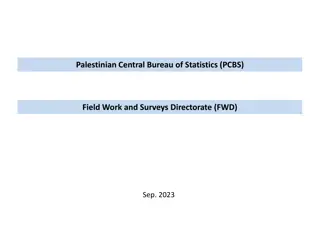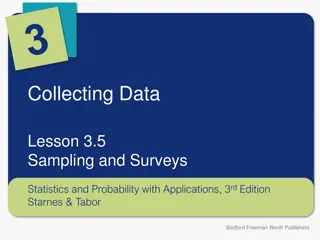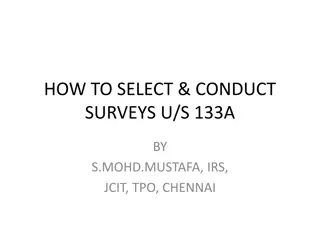
Data Sampling and Surveys for Statistical Analysis
Learn about qualitative and quantitative data, univariate and bivariate datasets, types of sampling methods, and evaluating sample validity in statistical studies. Explore examples and methods for effective data collection and analysis in surveys.
Download Presentation

Please find below an Image/Link to download the presentation.
The content on the website is provided AS IS for your information and personal use only. It may not be sold, licensed, or shared on other websites without obtaining consent from the author. If you encounter any issues during the download, it is possible that the publisher has removed the file from their server.
You are allowed to download the files provided on this website for personal or commercial use, subject to the condition that they are used lawfully. All files are the property of their respective owners.
The content on the website is provided AS IS for your information and personal use only. It may not be sold, licensed, or shared on other websites without obtaining consent from the author.
E N D
Presentation Transcript
12-5 Samples and Surveys
Quantitative: data measure quantities and can be described numerically Example: test scores, ages, time, weight Qualitative: data name qualities and can be words or numbers Example: Sports, zip codes, hair color
Problem 1: Classifying Data Is each set Qualitative or Quantitative? 1) Favorite Movies 2) Number of students in different school who take Spanish 3) Football Jersey Numbers
Univariate: a set of data that uses only one variable Bivariate: a set of data that uses two variables
Problem 2: Identifying Types of Data Is each data set univariate or bivariate? 1) The atomic weights of the elements in the periodic table 2) The edge lengths and volumes of cubes 3) Heights and weights of mammals 4) The cost of Internet service from several different providers
Populations: the entire group that you want information about Sample: When a population is too large to survey, statisticians survey a part of it to find characteristics of the whole. This part is called the Sample
NAME SAMPLING METHOD Survey a population at random EXAMPLE Random Survey people whose names are drawn from a hat Systematic Select a number n at random. Then survey the nth person Select the number 5 at random. Survey every fifth person Stratified Separate a population into smaller groups, each with a certain characteristic. Then survey at random within each group. Separate a high school into 4 groups by grade level. Survey a random sample of students from each grade
Problem 3: Choosing a Sample You want to find how many DVDs students at your school rent in a month. You interview every tenth teenager you see at a mall. What sampling method are you using? Is this a good sample
You revise your plan and interview all students leaving a school assembly who are wearing the school colors. Will this plan give a good sample? Explain.
BIAS: when a survey contains assumptions that may or may not be true. It can influence opinion and can make one answer seem better than another.
Problem 4: Determining Bias in a Survey A reporter wants to find out what kinds of movies are most popular with local residents. The reporter asks Do you prefer exciting action movies or boring documentaries? Is the question biased? Explain.






















